
10 Apr TIO NYC: Art Stops & More
Pill bottles, elastic bandages, and a nail clipper are among the motorized items in a rusty old medicine cabinet attached to the gallery wall, each able to tell time in a different world city A mop whines in an almost-human, but fully comprehensible voice. A huge exploded blown-out tire is torqued to bear a strong compositional resemblance to the ancient Greek sculpture Laocoön and His Sons. “Board Clock” tells the time with an altered knot in its grain, one ring counting the hours.
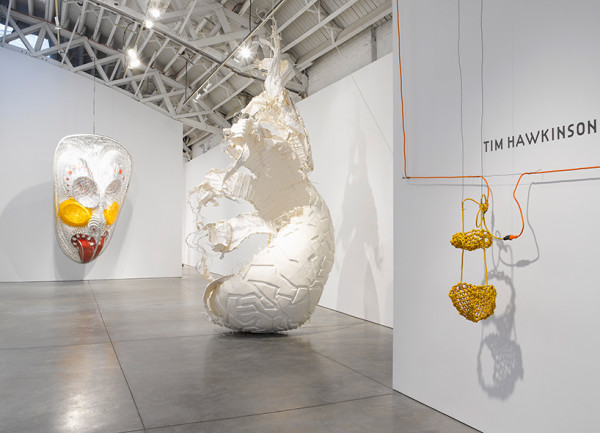
“Orrery, 2010,” a 93” high seated lady at a spinning wheel, turns many ways at once. The title refers to the universe, its rotating planets, and time.
The show at the Pace Gallery, 537 West 24 Street,“Counterclockwise,” features the work of conceptual artists, sculptor (and mad scientist?) Tim Hawkinson, (through April 23). The 14 works and two large drawings meld animation, electronics, and quotidian materials to explore highly imaginative, always humorous notions about time and the cosmos.
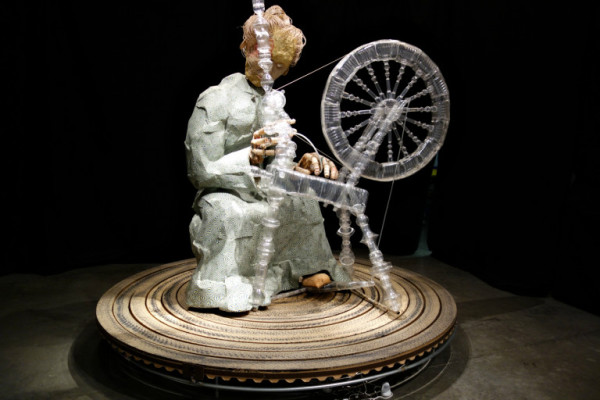
“Counterclockwise” is just one of several very different, equally engaging shows worth checking out in Chelsea this month.
Fans of “Harry Potter” – and who young or old isn’t – know that people in photographs and paintings can move and talk, particularly those who inhabit portraits that hang all over Hogwarts School. Variations on that theme grace the walls at the Paul Kasmin Gallery, 293 10th Avenue (through April 23).
Jim Nares’ “Portraits,” an exhibition of 11 new videos works, use high-speed camera to capture motion in terms the artist describes as “micro-moments.”
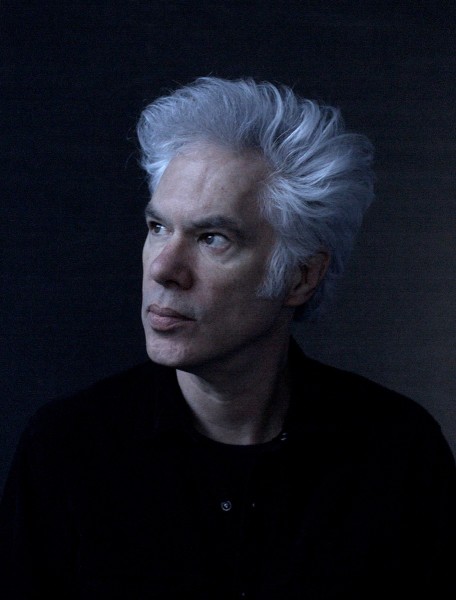
In other words, friends, family, and associates of Nares—among them, Glenn O’Brien, Hilton Als, Jim Jarmusch, and Amy Taubin—are rendered in startlingly high-resolution, supremely intimate video. Viewed on the near-life-sized monitors, these animated portraits evoke old masters such Rembrandt, Van Eyck, Sargent,Velasquez the list goes of iconic portraitists goes on – but these images were filmed at 600 frames per second.
“Nares’s filmed portraits slow down natural movement so that, at times, you have to remind yourself what exactly you’re looking at: musculature rippling under a cheek, brackish pools of eyes, the many varied lines and crags that make up or are mistaken for personality. It’s wild and weird and more than a bit thrilling, what Nares has done, offering the opportunity to really look at someone, which is not a small thing,” said Vanity Fair.
The effect is mesmerizing and beguiling, at once soothing and unnerving.
At Ameringer/McEnery/Yohe, 525 West 22nd Street, (through April 16), tiny cuts and spherical caverns of color radiate across surfaces to reveal kaleidoscopic layers of acrylic paint worked to resemble starbursts or chrysanthemums or….
Applying layer upon layer, color after color, alternating between different shades of acrylic paint, David Allan Peters gradually builds each work before cutting, scraping, and carving into the surface of his canvas.
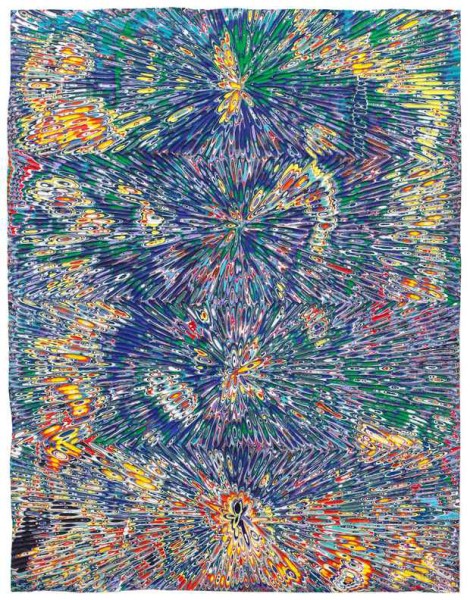
Using severs and scrapes to gesture, the artist excavates his 3D tactile surfaces to mark the passage of time, the days, weeks, months over which each painting matures being captured in the alternating colors.
The resulting images look and feel like postmodern mandalas.
Know the name Alexis Rockman? Unless you are a trivia – or film – buff, his name may not roll off the tip of your tongue. But Rockman was the production designer for Ang Lee’s gorgeous film, ‘Life of Pi.” And for nearly three decades, the artist has been painting “natural history psychedelia.”
Rockman’s latest show is “Bioluminesence” at the Carolina Kitsch Project Room,534 West 22nd Street (through April 30).
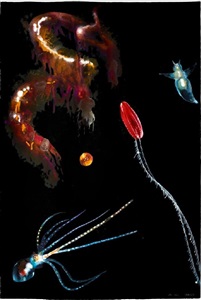
Time Out gives a thumbnail sketch of the magic that’s in store:
Rockman, who has said his work was inspired by childhood visits to the American Museum of Natural History, emerged in the 1980s with fantastical paintings of flora and fauna, often portrayed in post-apocalyptic setting, limned in a style that married dire ecological warnings with magic realism. His career has included work for Hollywood, most notably the concept drawings he created for Ang Lee’s film of Life of Pi. His latest show plunges into the briny deep with images of bioluminescent sea creatures lighting up gouaches on black paper.
The work of iconic abstract painter Serge Polikoff (1900 – 1969) lights up the walls of the Cheim & Read Gallery, 547 West 25 Street (through April 30).
From the gallery’s description:
At a moment when the accepted canon of abstract painting is in radical revision, an encounter with the work of Poliakoff is the best kind of rediscovery: it disrupts our sense of continuity as it restores it.
A product of the Russian diaspora that followed the Bolshevik Revolution, Poliakoff fled to the West, educating himself in the art schools and museums of London and Paris. He painted every day while raising a family, supporting this life by playing Russian folk songs on guitar in Parisian nightclubs late into the night. This hectic existence lasted well into his forties, when twenty years of foundational pictorial research finally came to fruition in a distinctive synthesis of painterly sensuality and ideational planarity.
Professional recognition increased his productivity and ambition resulting in a further twenty years (the remainder of his life) of paintings, gouaches, prints and related decorative projects that many consider the high-water mark of the “Nouvelle Ecole de Paris.”
Poliakoff’s interlocking planes built from physically seductive color fields appear nearly three-dimensional, inviting the viewer into the world of abstraction.
“Human Interest: Portraits from the Whitney’s Collection”(through February 2017) offers new perspectives on one of art’s oldest genres.
Drawn entirely from the Museum’s holdings, the more than 100 works on view reveal how artists have reinvented portraiture during the last 60 years. A mix of iconic works, lesser-known examples and recent acquisitions of the genre in a range of mediums, the exhibition unfolds in five thematic sections, (with additional sections opening on the seventh floor later this month).
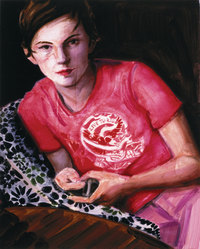
Some of these groupings concentrate on focused periods of time, while others span more broadly to forge links between past and present. This sense of connection is one of portraiture’s most important aims, whether memorializing famous individuals long gone or calling to mind loved ones near at hand.
Among the most notable examples: Alice Neel’s portrait of Andy Warhol and a work by an African artist, Njideka Akunyli Crosby entitled “Portals.” Also an unusual (i.e. rarely seen) group portrait by Alex Katz. Plus lots of wonderful photos and videos.
Filmmaker and journalist Laura Poitras’s first solo museum show, “Astro Noise” – her award-winning 2015 documentary “Citizenfour” about Edward Snowden screened at the Telluride Film Festival – debuted at the Whitney in February (through May 1).
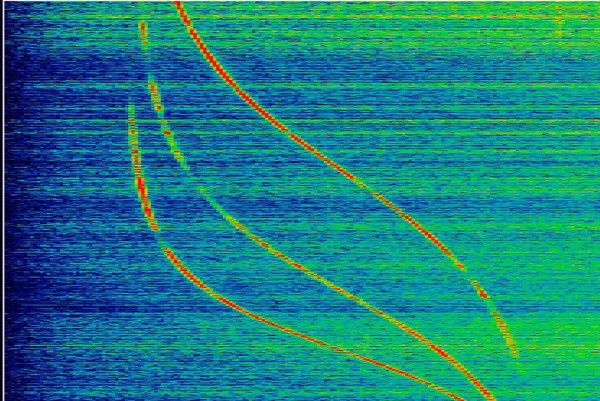
The show’s name refers to the faint background disturbance of thermal radiation left over from the Big Bang – and is the name Snowden gave to the encrypted file containing evidence of mass surveillance by the NSA, which he shared with Poitras in 2013.
The video work builds on topics important to the outspoken artist: mass surveillance, the war on terror, the U.S. drone program. Guantanamo, occupation and torture.
Josh Aronson’s book launch for “Orchestra of Exiles.”
Some would say it is not quite as terrifying as riding 2000 pounds of fury; others would prefer bull-riding to public speaking.
Part-time Telluride local Josh Aronson is familiar with both.
Josh’s doc “Bullrider” was released in the early 2000s at a soft opening in Telluride. The testosterone-laced drama is about the manliest of men (no quiche, no tears) whose day job is jumping on thousands of pounds of lean and mean. The film took us to the heart of the 2004 PBR finals in Las Vegas.
Josh’s latest doc, “Orchestra of Exiles” tells the dramatic story of Bronislaw Huberman, the celebrated Polish violinist who rescued some of the world’s greatest musicians from Nazi Germany, then created one of the world’s greatest orchestras, the Palestine Philharmonic (which would become the Israeli Philharmonic).

We attended the official launch of the related book, also ‘“Orchestra of Exiles,” on April 6, in a beautiful, apt setting at the New York Museum of Jewish Heritage, Edmond J. Safra Plaza, 36 Battery Place New York, NY, where Josh spoke as eloquently as he does with a camera.
All we can say is:
Move over Charlie Rose.
And, buy the book.



Sorry, the comment form is closed at this time.